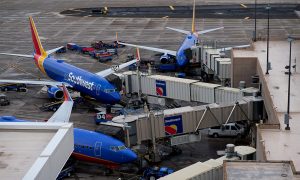In 2006, jet fuel became the biggest expense on the balance sheets of U.S. airlines. And airlines have been battered by volatile fuel prices in the past 10 years, even when they buy hedges to protect against cost spikes.
Right now, oil prices are down, but nobody expects them to stay there. That is why Airlines for America, the trade organization for the largest U.S. carriers, says its members are working to develop environmentally friendly fuels that could enhance the nation’s energy supply and reduce emissions.
Every $1 increase in a barrel of crude oil per year costs the airlines $415 million, so alternative fuels could become an alternative to petroleum-based fuels that would reduce price volatility for airlines and their customers, while bringing environmental benefit.
To that end, A4A, as the airline group is known, is a founding and principal member of the Commercial Aviation Alternative Fuels Initiative (CAAFI). This is a coalition of airlines, government, manufacturers, fuel suppliers, universities, airports and other stakeholders created to encourage the research, production and use of sustainable alternative aviation fuels.
CAAFI and its partners are currently studying three alternative fuels:
- Fischer-Tropsch Fuels: The process converts a mixture of hydrogen and carbon monoxide—derived from coal, methane or biomass—to liquid fuels, commonly known as Coal-to-Liquids;
- Hydrotreated Renewable Jet (HRJ) Fuels: These fuels are produced by refining natural plant oils or animal fats, that converts them from lipids to hydrocarbons through the addition of hydrogen. These hydrocarbons are processed to produce diesel, jet fuel and propane; and
- Renewable Synthesized Iso-Paraffinic (SIP) Fuels: These fuels are produced from hydroprocessed fermented sugars. SIP fuel may be blended at up to 10 percent (by volume) with conventional jet fuel.
CAAFI says that environmentally friendly alternative jet fuel derived from several feedstocks will be available to airlines within the next two to five years. “The types and volumes of alternatives reaching the marketplace will depend on many forces, including the extent of governmental support, new technological developments and investor interest,” it said.
Airlines around the world have been testing biofuels. One of the first was Seattle-based Alaska Airlines, which began flying 75 commercial passenger flights using a 20 percent blend of sustainable biofuel made from used cooking oil during testing that started in November 2011.
At the same time, Continental Airlines flew a demonstration flight on a Boeing 737-700 using a biofuel blend that included components derived from algae and jatropha plants. And in September, Southwest Airlines signed a $3 million deal with Red Rocks Biofuels LLC to buy low-carbon renewable jet fuel, made from forest residues using the Fischer-Tropsch process to refine organic material into fuel.
Story Ideas
Commercial Aviation Alternative Fuels Initiative
International Air Transport Association
International Civil Aviation Organization
Benét J. Wilson is co-editor of AirwaysNews.com and blogs at AviationQueen.com. She has been an aviation/travel journalist for more than 20 years. Follow her on Twitter @AvQueenBenet










